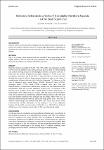| dc.description.abstract | BACKGROUND
Delay in referral adversely affects maternal and neonatal outcome. We wanted to
review the obstetric referrals, source of referrals, appropriateness of referrals and
document the maternal and perinatal outcomes in a tertiary hospital in northern
Uganda.
METHODS
This is a secondary data analysis from case records. A descriptive study of 780
eligible obstetric referrals, with ≥28 week’s gestation, referred to the hospital for a
period of 12 months were analysed with SPSS version 23.
RESULTS
Obstetric referrals accounted for 16.3% (780/4799) of the total admissions in 2018,
43.8% were from CEMNOC sites and 32.3% from HC IVs, while 57% from without
Lira District, showing lacunae in the emergency obstetric care given at the HC IV
levels and the districts hospital in the region. Majority or 93.5% (729) were
intrapartum admissions and 98.1% (715) of these had labour outcome recorded,
showing the nature of referrals. Most common diagnosis at referral was labour or
complications of labour and only 4.6% had other diagnoses. The diagnoses at the
time of admission were normal labour (31.0%); obstructed labour (25.1%);
prolonged labour (7.1%). About 29.9% presented with more than one
medical/obstetric complications, and the most common one was obstructed labour,
preeclampsia, IUFD and previous caesarean section scars. The outcome of the
referred cases included 45.1% (327) vaginal delivery (either spontaneous or
augmented), 54.4% (396) caesarean section, 0.5% (4) Caesarean hysterectomy,
3.1% (24) transferred out undelivered, 1.2% (09) missing outcome while the 3.6%
(28) with medical conditions were managed and discharged. There were ten (10)
maternal deaths among the referrals, during the study period and 3 were due to
obstetric haemorrhage; and behind these there were many near misses which
would provide valuable information on the quality of care at the peripheral
facilities. 80.4% (627) were live babies, 10.5% (82) were FSB/MSB and 10% had
APGAR score ≤5 at 5 minutes of birth while 13.2% were of low birth weight.
CONCLUSIONS
A wide spectrum of complicated and uncomplicated obstetric cases was referred to
this hospital and majority were unjustifiable as majority of the referred conditions
could be managed at the lower CEMONC sites. Unavailability of Comprehensive
Emergency Obstetric Care (CEMONC) was the most common reason for referrals,
even where infrastructure and human resource where known to be available. Most
common diagnosis at the time of referral was prolonged/obstructed labour. Even
today, obstetric haemorrhage is the leading cause of maternal mortality while
prolonged/obstructed labour contributed to the high neonatal mortality.
KEY WORDS
Obstetric Referrals, Maternal, Outcome, Foetal Outcome, Referral Sites, Tertiary | en_US |

